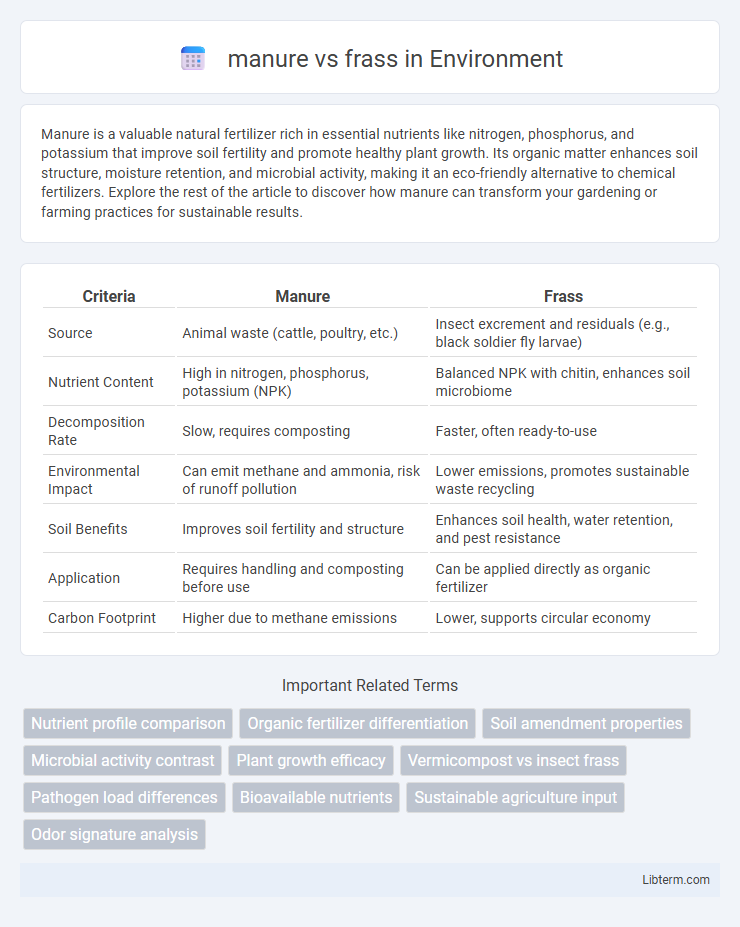Manure is a valuable natural fertilizer rich in essential nutrients like nitrogen, phosphorus, and potassium that improve soil fertility and promote healthy plant growth. Its organic matter enhances soil structure, moisture retention, and microbial activity, making it an eco-friendly alternative to chemical fertilizers. Explore the rest of the article to discover how manure can transform your gardening or farming practices for sustainable results.
Table of Comparison
| Criteria | Manure | Frass |
|---|---|---|
| Source | Animal waste (cattle, poultry, etc.) | Insect excrement and residuals (e.g., black soldier fly larvae) |
| Nutrient Content | High in nitrogen, phosphorus, potassium (NPK) | Balanced NPK with chitin, enhances soil microbiome |
| Decomposition Rate | Slow, requires composting | Faster, often ready-to-use |
| Environmental Impact | Can emit methane and ammonia, risk of runoff pollution | Lower emissions, promotes sustainable waste recycling |
| Soil Benefits | Improves soil fertility and structure | Enhances soil health, water retention, and pest resistance |
| Application | Requires handling and composting before use | Can be applied directly as organic fertilizer |
| Carbon Footprint | Higher due to methane emissions | Lower, supports circular economy |
Introduction to Manure and Frass
Manure, a traditional organic fertilizer derived from animal waste, enriches soil with nitrogen, phosphorus, and potassium essential for plant growth. Frass, the excrement of insect larvae, specifically black soldier fly larvae, presents a nutrient-rich alternative containing beneficial microbes and chitin that enhance soil health and pest resistance. Both manure and frass contribute to sustainable agriculture by recycling organic waste and improving soil fertility.
Defining Manure: Sources and Types
Manure is organic matter primarily derived from animal feces, urine, and bedding materials, widely used as a natural fertilizer to enhance soil fertility and structure. Common sources include livestock such as cattle, horses, poultry, and pigs, each producing manure with distinct nutrient compositions crucial for targeted agricultural applications. Types of manure vary from raw manure, composted manure, to slurry, with composting improving nutrient availability and reducing pathogens, making it a sustainable choice for soil amendment.
What is Frass? Origins and Composition
Frass is the organic waste produced by insects, primarily composed of insect excrement, shed skins, and partially digested plant material. Originating from insect larvae such as beetles, crickets, and black soldier flies, frass contains beneficial microbes, chitin, and nutrients like nitrogen, phosphorus, and potassium. Unlike traditional manure derived from animal feces, frass serves as a nutrient-rich, sustainable fertilizer with natural pest-deterring properties.
Nutrient Profiles: Manure vs Frass
Manure typically contains higher levels of nitrogen, phosphorus, and potassium, essential macronutrients for plant growth, but its nutrient content can vary significantly based on the animal source and bedding materials. Frass, the organic residue produced by insect larvae, offers a balanced nutrient profile with consistent levels of nutrients and additional beneficial microbes that enhance soil health and nutrient availability. Both manure and frass improve soil fertility, but frass often provides a more stable and microbial-rich nutrient source.
Soil Health Benefits: Comparative Analysis
Manure and frass both enhance soil health by improving nutrient content and microbial activity, with manure providing a broader spectrum of essential nutrients such as nitrogen, phosphorus, and potassium. Frass, a byproduct of insect digestion, offers higher concentrations of chitin and beneficial microbes that stimulate soil biodiversity and plant immunity. Studies indicate that frass accelerates nutrient cycling and promotes stronger root development, making it a potent supplement alongside traditional manure for sustainable agriculture.
Environmental Impact: Sustainability Aspects
Manure is rich in nutrients but can contribute to greenhouse gas emissions and water contamination if not managed properly, affecting soil and water quality. Frass, the byproduct of insect larvae digestion, offers a more sustainable alternative with lower emissions, reduced pathogen risk, and improved soil health due to its balanced nutrient profile and organic content. Using frass as a biofertilizer supports circular agriculture by recycling organic waste and enhancing soil microbial activity, resulting in a smaller environmental footprint compared to conventional manure.
Application Methods and Best Practices
Manure application methods include surface spreading, injection, and incorporation to minimize nutrient loss and odors, with timing aligned to crop nutrient demand for optimal efficiency. Frass, a byproduct of insect farming, is typically applied as a powder or diluted slurry, enhancing soil microbiota and plant growth with lower nutrient runoff risk. Best practices for both involve soil testing, appropriate application rates, and avoiding use before heavy rainfall to prevent leaching and environmental contamination.
Cost and Availability
Manure is typically more widely available and cost-effective due to its abundance from livestock farms and established supply chains, making it a common choice for large-scale agriculture. Frass, derived from insect larvae excrement, tends to be more expensive and less accessible as its production is niche and dependent on insect farming industries. The higher cost of frass is often justified by its superior nutrient profile and pest-repelling properties, but availability remains limited compared to conventional manure.
Safety Considerations: Pathogens and Odors
Manure often contains pathogens like E. coli and Salmonella, requiring careful handling and composting to reduce health risks and unpleasant odors. Frass, the excrement of insects, generally poses fewer pathogen concerns and emits less odor, making it a safer alternative for use in organic farming. Proper storage and application methods further minimize potential safety hazards associated with both materials.
Choosing the Right Fertilizer for Your Needs
Manure and frass both serve as effective organic fertilizers but differ in nutrient content and application benefits. Manure typically provides a balanced mix of nitrogen, phosphorus, and potassium, enriching soil structure and microbial activity, while frass, derived from insect excrement, is rich in chitin and beneficial microbes that enhance plant immunity and soil health. Selecting the right fertilizer depends on your soil condition and crop requirements; manure is ideal for improving overall soil fertility, whereas frass is preferred for boosting plant resilience and promoting sustainable pest management.
manure Infographic

 libterm.com
libterm.com